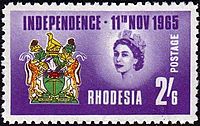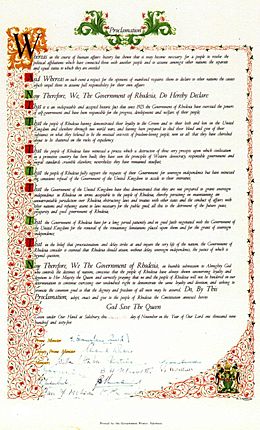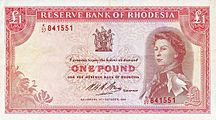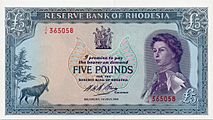Queen of Rhodesia facts for kids
Quick facts for kids Queen of Rhodesia |
|
|---|---|

Coat of arms of Rhodesia
|
|

Stamp issued December 1965
|
|
| Details | |
| Style | Her Majesty |
| Formation | 11 November 1965 |
| Abolition | 2 March 1970 |
The Queen of Rhodesia was a special title that people in Rhodesia (now Zimbabwe) used for Elizabeth II. This happened after Rhodesia declared itself independent from the United Kingdom on November 11, 1965.
However, almost no other country in the world, including the British government and the United Nations, agreed that Rhodesia was truly independent. They saw Rhodesia's declaration as illegal. This meant that the idea of Elizabeth II being a separate "Queen of Rhodesia" was not accepted anywhere else. When Rhodesia became a republic in 1970, the title of Queen of Rhodesia officially ended.
Contents
How Rhodesia Declared Its Own Queen
Before 1965, Rhodesia was a British colony called Southern Rhodesia. This meant it was controlled by Britain, but it also had its own government that managed many local affairs. The British monarch was automatically seen as the monarch of the colony.
In 1965, the UK refused to give Southern Rhodesia full independence because the country was ruled by a white minority. The British government wanted to make sure that everyone, including the black majority, had a say in the government.
So, on November 11, 1965, Rhodesia's government decided to declare independence on its own. They still said they were loyal to Queen Elizabeth II. They believed she was their own Queen of Rhodesia, separate from her role as Queen of the United Kingdom. This was sometimes called a "loyal rebellion" because they were breaking away from the British government but not from the Queen herself. All official promises in Rhodesia still mentioned her, and their declaration of independence ended with "God Save The Queen."
Britain's Response
The British Parliament quickly passed a law called the Southern Rhodesia Act 1965. This law said that Britain still controlled the colony. Queen Elizabeth II then used her power to suspend Rhodesia's government and fire its leader, Prime Minister Ian Smith.
However, the Rhodesian government ignored these actions. Ian Smith said that these orders came from the British government, not from the Queen of Rhodesia. The Rhodesians believed that the Queen's power could be divided, meaning she could be Queen of Rhodesia without being controlled by the British government.
The Rhodesians also stopped recognising Sir Humphrey Gibbs, who was the Queen's official representative in Southern Rhodesia. Smith even asked Queen Elizabeth II to appoint a new representative for Rhodesia, but she refused. She said she could not accept advice from Smith because she no longer recognised him as Prime Minister.
Because the Queen refused to appoint a new representative, Smith appointed Clifford Dupont to act on her behalf. He was called the "Officer Administering the Government."
The Queen's Power in Rhodesia
Even after Rhodesia declared independence, the powers of the monarch were supposed to be the same as before. However, these powers were actually used by Clifford Dupont, the Officer Administering the Government, instead of by Sir Humphrey Gibbs, who was the Queen's true representative.
Every new law in Rhodesia would begin with a special phrase. It said that the law was made by the Officer Administering the Government, acting as the Queen's representative, with the agreement of the Rhodesian Parliament.
A Disputed Pardon
In 1968, Queen Elizabeth II tried to save three men in Rhodesia who had been sentenced to death. She used her royal power to pardon them. But the Rhodesian court ignored her pardon. They said that because Rhodesian officials were not asked, the pardon came from the British government, not from the Queen of Rhodesia. Sadly, the men were executed.
Symbols of the Queen
The Queen's picture was on Rhodesian banknotes and coins. She also appeared on their postage stamps.
- Queen Elizabeth II on Rhodesian banknotes
Rhodesia Becomes a Republic
Some people in Rhodesia wanted the country to become a republic, meaning it would have a president instead of a queen. After the Queen's pardon was ignored, the Rhodesian government decided that the Queen's Official Birthday would no longer be a public holiday.
In 1969, the Rhodesian government held a vote to decide if they should become a republic and create a new constitution. Prime Minister Smith argued for this change, saying that the British government had "denied us the Queen of Rhodesia." The people of Rhodesia voted in favor of becoming a republic.
The Roman Catholic Church was against this change. They worried it would make things even harder for black people in Rhodesia. Sir Humphrey Gibbs, the Queen's representative, resigned at this time.
Rhodesia officially became an unrecognised republic on March 2, 1970. Queen Elizabeth II then removed the "Royal" title from Rhodesia's air force and army. Clifford Dupont became the new president, replacing Elizabeth II as the head of state.
Smith had hoped that becoming a republic would make other countries recognise Rhodesia. But it had the opposite effect. Most countries that had kept their diplomatic ties with Rhodesia now withdrew them. They had kept relations because of the Queen, but once Rhodesia became a republic, that reason was gone.
Rhodesia remained an unrecognised republic until 1979. Then, it agreed to return to being a British colony for a short time. Queen Elizabeth II again became the monarch of the colony through her role as Queen of the United Kingdom. She appointed Lord Soames as her representative. Rhodesia finally gained full independence as Zimbabwe on April 18, 1980.





